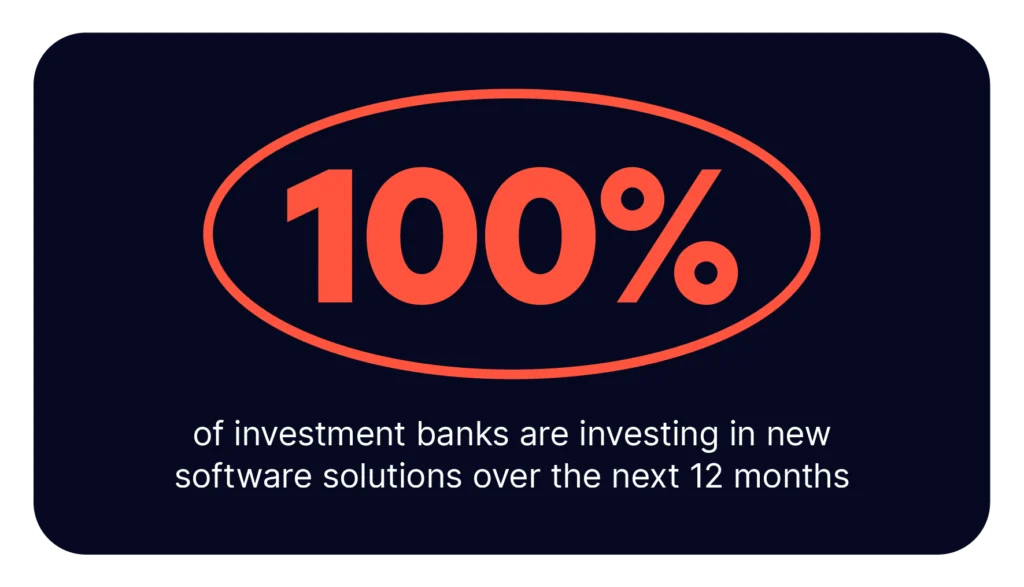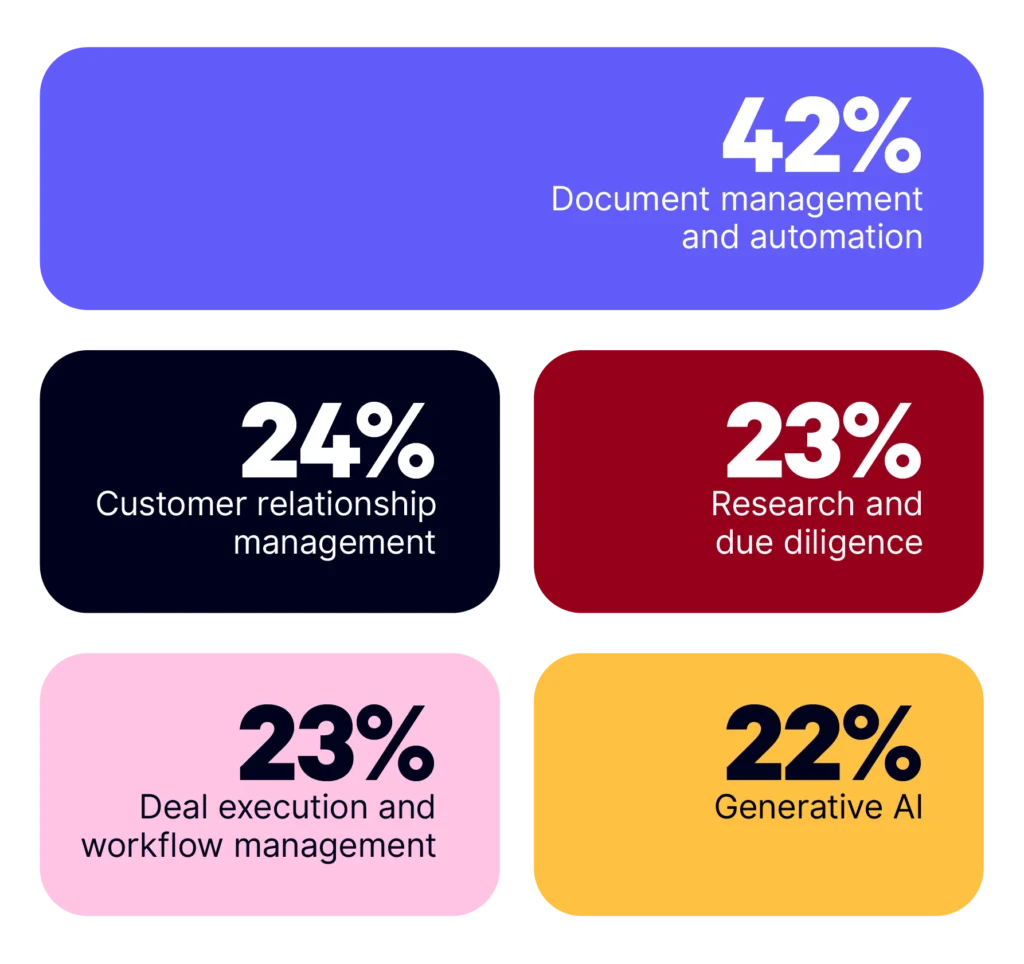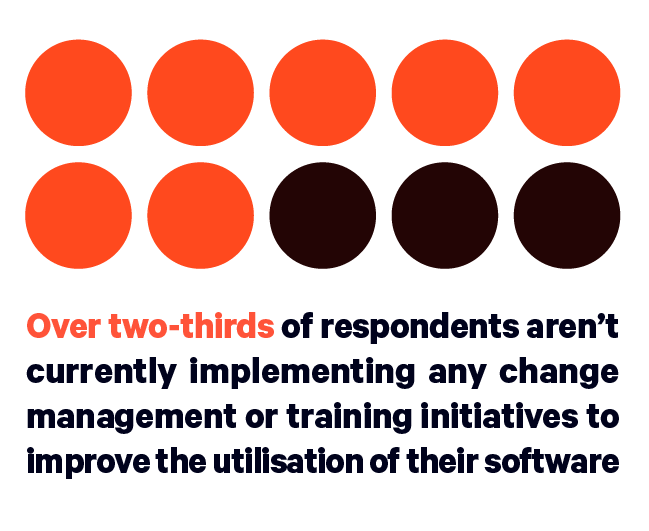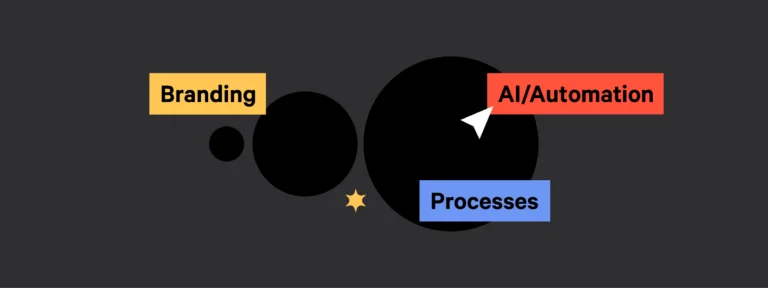When your firm is looking at investing in new tech, how do you choose a solution that will deliver long-term value to your teams?
We surveyed over 600 IT and Transformation professionals in global investment banks to find out how they’re approaching strategic tech investments in 2024 and beyond. Read on to find out how to choose a software that best fits your needs, and how to efficiently deploy it across your teams.
Introduction: Understanding the Critical Role of Software in Investment Banking
Across the investment banking sector, strategic investments in technology are pivotal for driving bottom-line success. In an industry where nearly a third of employees are spending 40 hours a week in Microsoft 365 alone, investment banking software – be it for document generation, reporting automation, or even brand compliance – can have a significant impact when it comes to boosting productivity, and raising the bottom line.
The Benefits of Saas Banking Technology
SaaS banking technology provides several advantages to teams on the ground, whether it’s saving time on manual tasks, automating proofing and compliance checks, or effectively monitoring deal flow and efficiency. Investing in banking software tools can also bring long-term benefits to firms such as optimizing cost-efficiency per employee, and freeing up internal R&D capacity for more impactful projects.
As UpSlide’s latest research shows, 100% of bankers are investing in new software in 2024. In the next section, we’ll explore what software banks are currently using, and what they plan to invest in for the future.

What Software Do Investment Bankers Use?
Investment bankers use a wide range of tools to manage workflows, analyze data, and improve decision-making. Here are some of the most impactful investment banking tools, along with their strengths and weaknesses:
Top Investment Banking Tools: Pros and Cons
CRM Systems
Examples: Salesforce, DealCloud
Pros:
- Streamlined relationship management for deal pipelines
- Comprehensive tracking of client interactions and deal progress
- Advanced integrations with analytics and document management platforms
Cons:
- Expensive licensing and maintenance
- Complex implementation, requiring dedicated training for teams
Financial Data Providers
Examples: FactSet, S&P Capital IQ
Pros:
- Robust forecasting and valuation tools
- Access to real-time financial data and historical trends
- Widely recognized and trusted by professionals
Cons:
- High costs, often out of reach for smaller firms
- May require additional training to unlock full functionality
Data Visualization Platforms
Examples: Power BI, Tableau
Pros:
- User-friendly dashboards for quick decision-making
- Ability to consolidate and analyze large datasets
- Real-time collaboration features for teams
Cons:
- Customization options may require technical expertise
- Limited advanced modeling compared to specialized tools
Document Automation
Examples: UpSlide, Pitchly
Pros:
- Efficient PowerPoint formatting tools
- Unbreakable data linking from Excel to PowerPoint
- Automated proofreading to enforce brand guidelines and prevent human error
Cons:
- Enterprise solutions, less suited to non-financial-services teams
- Premium pricing
A typical workflow for a transaction advisory team, for example, might involve logging an RFP within Salesforce, sourcing data for the proposal from FactSet, transforming the data in Power BI and Excel for custom visualization options, then collating it together with a PowerPoint automation tool, like UpSlide.
Discover how Meridian Capital cut their pitch creation time by 75% with UpSlide.
In leveraging a combination of these banking SaaS tools, firms are able to optimize their processes and enhance their competitive edge within the industry.
What Software Solutions Do Innovation Leaders Plan to Invest In?
When asked what SaaS banking technology IT and Innovation leaders are investing in this year, document management and automation came on top. Interestingly, generative AI was only considered by 22% of IT and Transformation leaders.

Do Bankers Want AI or Automation?
It’s hard to have a conversation about tech for investment banking without talking about AI; however, ask yourself first, do my bankers need AI or automation?
Amongst IT leaders in the US, for example, over a third feel confident about generative AI’s impact on the bottom line, yet only 24% are willing to invest; most likely due to the potential security and compliance risks it might introduce.
If your teams are hoping to speed up manual tasks like updating market data between Excel and PowerPoint in their pitchbooks, they might consider automation software first. If advanced analytics, internal knowledge sharing, or meeting transcription are on your radar, you may have a stronger case for AI.
Are Banks Building or Buying New Technology?
Decide Whether to Build or Buy
When it comes to tech solutions for investment banks, the build vs buy question is always top of mind.
Historically, banks would invest considerable resources on building their internal tech stack. However, with the rise of more specialized third-party solutions, more and more investment banks are looking outward instead of building in-house.
Building and maintaining an internal software solution can be a drain on resources. Despite the advantages of being able to customize a tool to your exact needs, building software in-house requires constant testing and maintenance when rolled out to front-line teams.
There are some exceptions, such as Blackrock’s portfolio management software, Aladdin, or the GPT-based proprietary AI solutions coming from PwC, Goldman Sachs, or Bloomberg; however, opting to build across a variety of use-cases and teams can spread resources thin and lead to maintenance issues across your business down the line.
In light of this difficulty, close to 60% of digital transformation and IT teams are now sourcing over half of their tech stacks from external providers.
In this next section, we’ll look at how leading investment banks are evaluating these external providers.
How to Choose the Right Investment Banking Software
1: Assess Your Tech Requirements
First off, start by assessing the requirements of your team. If you’ve already done this, skip to here: Conduct Market Research and Software Evaluation.
Evaluate your existing processes to identify gaps and areas for improvement. Are there any bottlenecks in your workflows? Are there any inefficient or under-used software that could be replaced?
Talk to the teams that stand to benefit the most from your new software purchase. Uncover their painpoints to ensure the new tooling best meets their needs.
2: Conduct Market Research and Software Evaluation
After assessing your needs, it’s time to search for a solution that will fit them. Be as thorough as possible here; any footfalls you identify here will be ones you avoid down the line. Let’s consider what survey respondents identified as their priorities when choosing a provider for a new investment banking tool.
What do Investment Banks Look for When Choosing a Saas Vendor?
Aside from the features and functionality of the tool, banks are more interested in training and adoption support, as well as the ability to provide clear ROI metrics. Market segment expertise, though lower in priority, is also essential.

Consider these key questions during your search for your next software provider:
Are They Use-Case and Industry-Specific?
92% of investment banks are using automation solutions tailored to either their industry or team-specific use cases. Assess how much of the tool’s functionality encompasses your team’s workflow. The closer the overlap, the smoother the implementation and the greater the benefits.
Software solutions with a specific industry focus will have features designed to answer some of the industry’s unique problems. If a tech vendor has a lot of client testimonials for investment banking, it’s more likely that their functionality will support your firm’s needs.
Are They an All-In-One Solution?
29% of IT and innovation teams are prioritizing consolidating their tech stack with all-in-one solutions when it comes to searching for new software. If a vendor offers functionality over multiple platforms it will drive smoother adoption and scalability across your whole business.
Will They Be Responsive to My Needs?
Aside from the strength of the product, it’s also important to choose a vendor that offers consistent support and value down the line. That’s why over two-thirds of banks are committing to stricter vendor SLAs and internal due diligence during the buying process, trying to suppress any potential risks as early as possible. Within these SLAs, dedicated adoption and deployment support and clear ROI metrics are top priority for investment banks today.
Getting these right will have a considerable impact on your long-term ROI. As part of your search, consider issuing an RFP where you will be able to define your requirements in full detail to match with the most suitable provider.
UpSlide really took care of the structure of the project, leaving us to focus on our core tasks. The communication was perfect throughout.

Marcin Stefànski
Application Analyst

How to Effectively Deploy Your Tool
Having chosen your desired investment banking software, it’s now time for the deployment phase. The implementation and adoption phase can make or break the ROI you get from a new tech investment. However, it’s surprising how many investment banks neglect this stage of the software deployment cycle. Over two-thirds of investment banks are not currently implementing change management or training initiatives to improve the utilization of their software.

Ensure a Smooth Deployment of Your Chosen Solution
Step 1: Establish a Project Plan
Develop a detailed project plan outlining timelines, milestones, resources, and responsibilities. Establish key performance indicators (KPIs) to monitor beyond the deployment phase so you effectively track your productivity gain and overall project success.
Step 2: Organize a Phased Rollout
Implement the software in phases, starting with a pilot group before a full-scale deployment. A strong change management approach can have a considerable impact on long-term success. By starting with a smaller group, you can gather detailed feedback and ensure the wider rollout will be better received by the business.
Step 3: Create a Training and Support Plan
Organize dedicated training plans to ensure your team is benefitting the most from the tool’s functionality. Some investment banking software providers will do this for you, working with your internal teams to ensure smooth roll-out and implementation.
Step 4: Implement a Feedback Cycle
Establish a feedback mechanism to collect user experiences and suggestions for improvement. UpSlide relies heavily on the feedback of our users in financial services to continue delivering the best possible support for their workflows. We’ve developed features in partnership with Alvarez & Marsal, KPMG, BNP Paribas, and other key players across financial advisory and investment banking.
Following these steps will ensure the smoothest deployment of your chosen investment banking software.
Ensure Success Post-Deployment
With any investment banking software, your success is not limited to the initial rollout. It’s important to have steps in place to maintain performance and true productivity gain down the line. Here are some steps that investment banking tech teams are taking to ensure long-term ROI on their latest software purchases:
Conduct a Performance Review
Assess the performance of the new software against the initial objectives and key performance indicators (KPIs). This should collate user feedback and performance data to highlight what areas are going well, along with clear ROI metrics to ease your reporting to senior management down the line.
Plan For Regular Updates and Maintenance
Anticipate regular updates, patches, and ongoing maintenance to ensure the software remains up-to-date and secure. Software providers with a responsive support team, or auto-update functionality, will help make this seamless on your end.
Continue Onboarding and Training
As your chosen solution develops new functionality, it’s essential to keep your bankers making the most of the software in the long-term. In partnership with your vendor, aim to run regular training sessions to accommodate new users (such as incoming graduates or interns), and update old users on new improvements.
Key Takeaways: Choosing the Right Investment Banking Software Solution
The right tools can revolutionize how your firm operates. From external SaaS tools to legacy platforms, selecting the right investment banking software solutions requires complete alignment with your strategic goals. Additionally, whether it’s document automation, AI, or cybersecurity, choosing a vendor that understands and responds to your needs is crucial.
Many firms have entered the year with a reduced budget, making it essential to maximize the value gained from each investment banking software purchase. The banks that successfully implement their chosen tech solutions will be the ones to see the greatest competitive gains through 2025 and beyond. Explore leading investment banking tools today to drive efficiency and maintain a competitive edge.
Discover how investment banks are leveraging automation software to maximize value per FTE.
TL;DR
Strategic tech investments drive productivity: Investment banking heavily relies on technology, with employees spending increasing amounts of time in Microsoft 365. Effective software solutions can boost productivity and improve the bottom line.
Avoid tech wastage: 68% of investment banks waste up to a quarter of their budget on unused tools due to poor training, ineffective change management, and decentralized tech stacks. Choosing the right software early on will help avoid this.
Thoroughly assess and select software: Conduct a detailed assessment of your tech requirements, decide between building or buying, and rigorously evaluate market options to find a software solution that meets your specific needs.
Ensure smooth deployment: Implement the chosen software effectively with a well-structured project plan, phased rollout, comprehensive training, and continuous feedback cycles to maximize ROI.
Maintain long-term success: Post-deployment, conduct performance reviews, plan for regular updates, and continue training to ensure sustained productivity and value from the investment.










